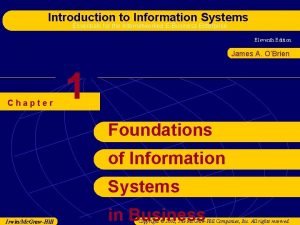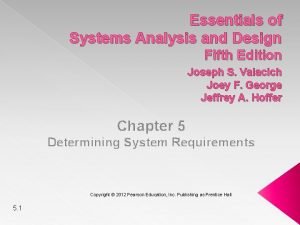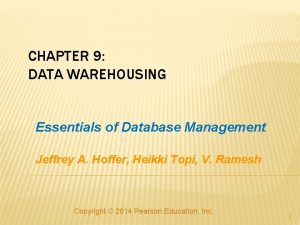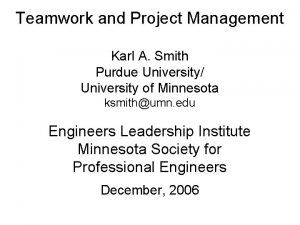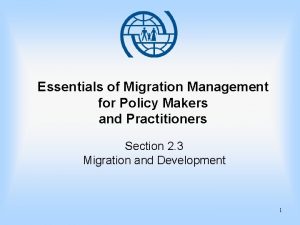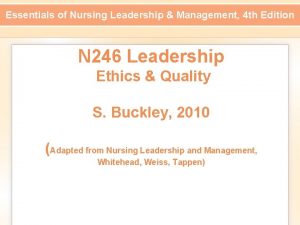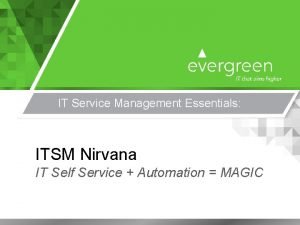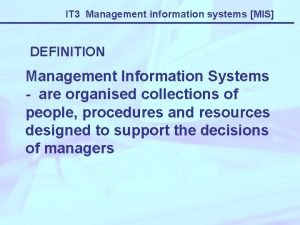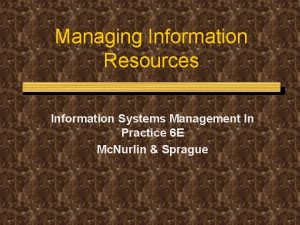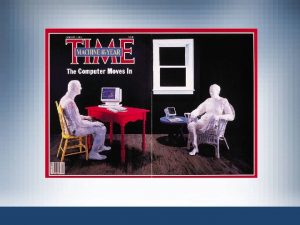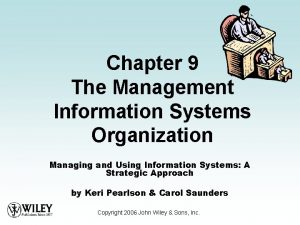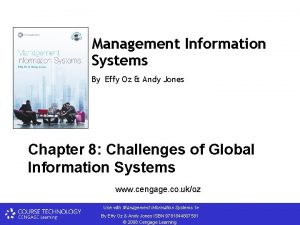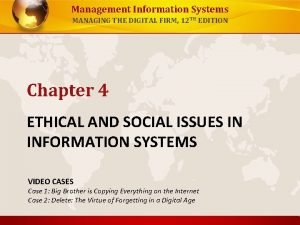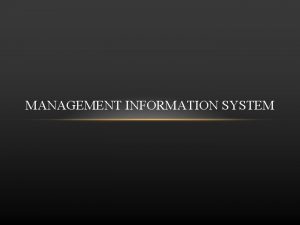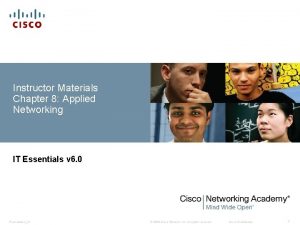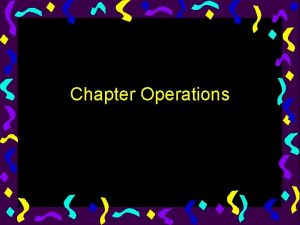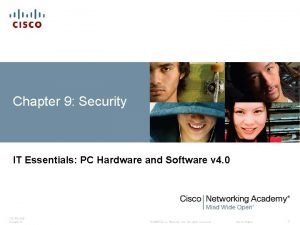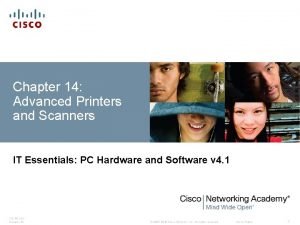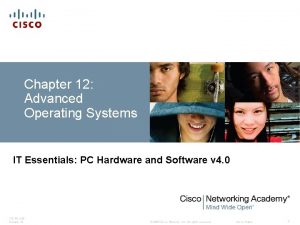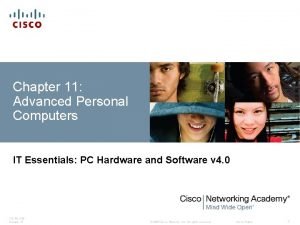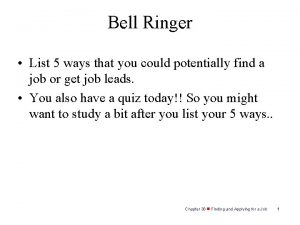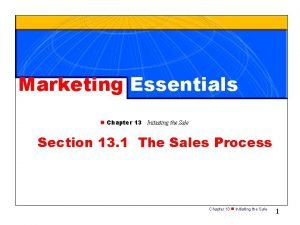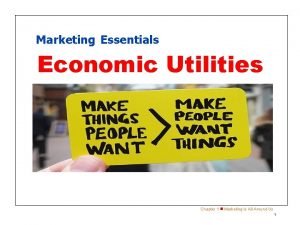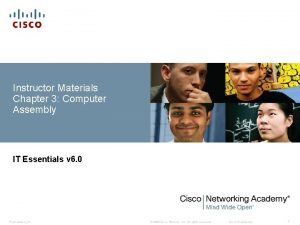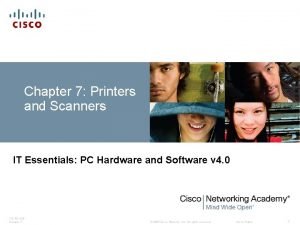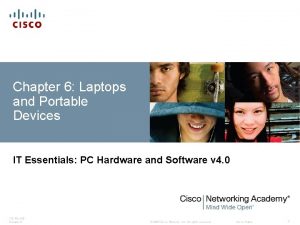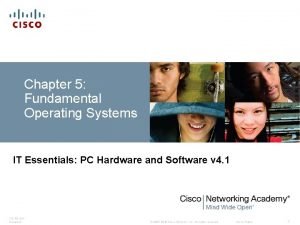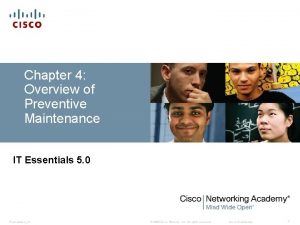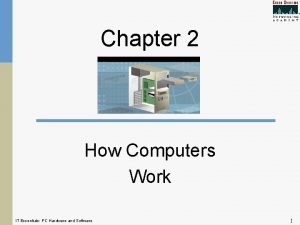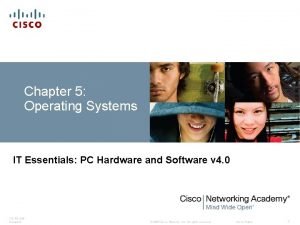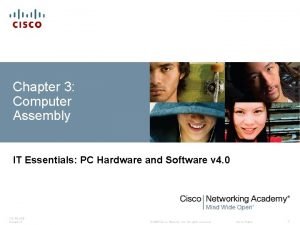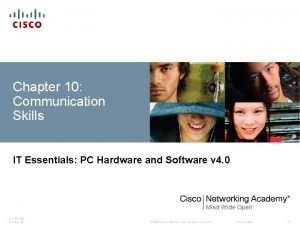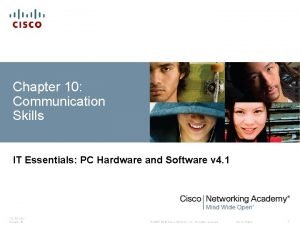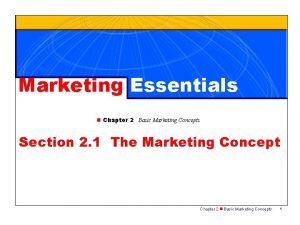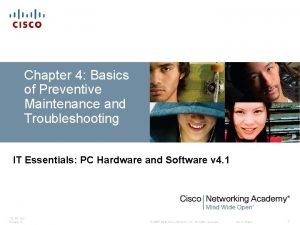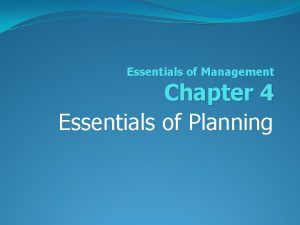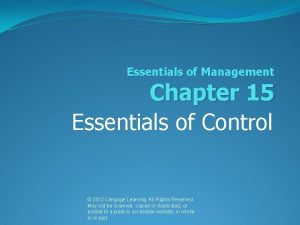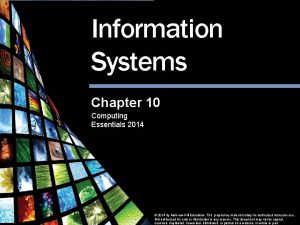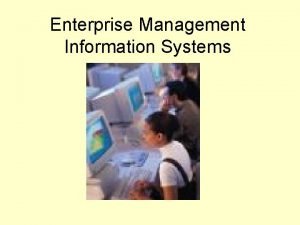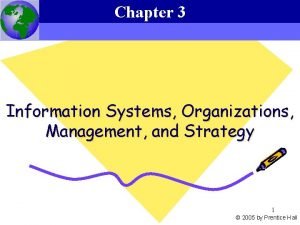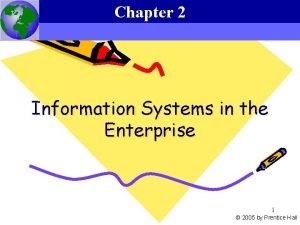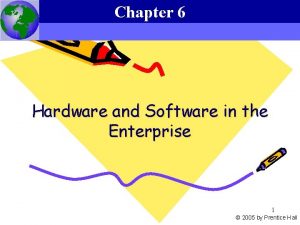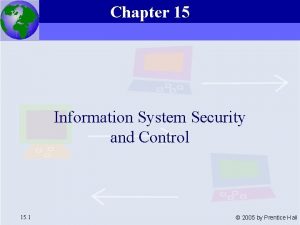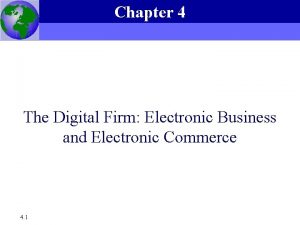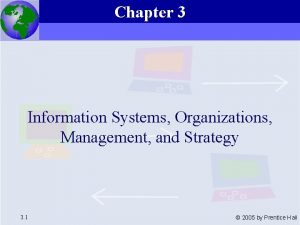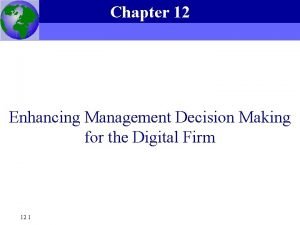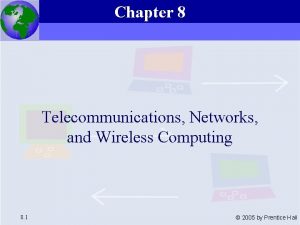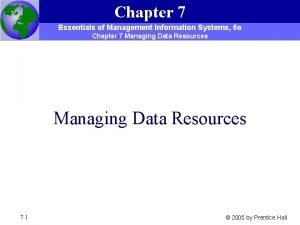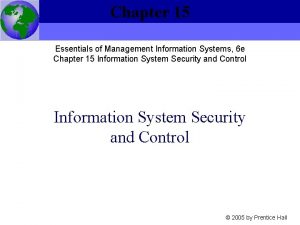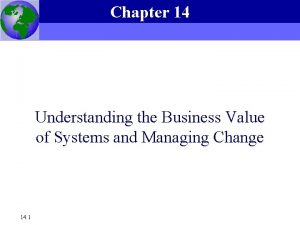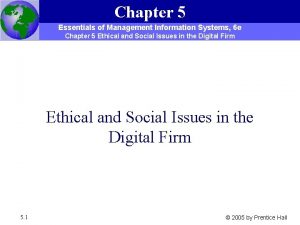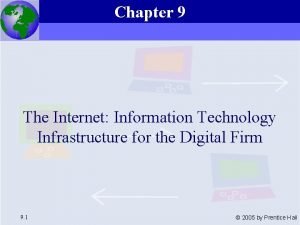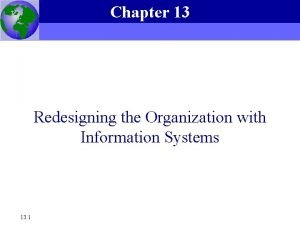Chapter 10 Essentials of Management Information Systems 6
















































- Slides: 48

Chapter 10 Essentials of Management Information Systems, 6 e Chapter 10 Enterprise Applications and Business Process Integration KOMPUTER (SISTEM INFORMASI) & INDUSTRI/ PERUSAHAAN Enterprise Applications and Business Process Integration 10. 1 © 2005 by Prentice Hall

Essentials of Management Information Systems, 6 e Chapter 10 Enterprise Applications and Business Process Integration Objectives 1. How do enterprise systems provide value for businesses? How does enterprise software work? 2. How do supply chain management systems provide value for businesses? What does supply chain management software do? 10. 2 © 2005 by Prentice Hall

Essentials of Management Information Systems, 6 e Chapter 10 Enterprise Applications and Business Process Integration Objectives 3. How do customer relationship management systems provide value for businesses? What does customer relationship management software do? 4. How can enterprise applications be used in platforms for new cross-functional services? 5. What are the challenges of implementing and using the various enterprise applications? 10. 3 © 2005 by Prentice Hall

Essentials of Management Information Systems, 6 e Chapter 10 Enterprise Applications and Business Process Integration Management Challenges 1. Thinking beyond the walls of corporation 2. Obtaining value from enterprise applications 10. 4 © 2005 by Prentice Hall

Essentials of Management Information Systems, 6 e Chapter 10 Enterprise Applications and Business Process Integration Enterprise Systems How Enterprise Systems Work • Enterprise Software: Set of integrated software modules for finance and accounting, human resources, manufacturing and production, and sales and marketing that allows data to be used by multiple functions and business processes 10. 5 © 2005 by Prentice Hall

Essentials of Management Information Systems, 6 e Chapter 10 Enterprise Applications and Business Process Integration 10. 6 © 2005 by Prentice Hall

Essentials of Management Information Systems, 6 e Chapter 10 Enterprise Applications and Business Process Integration Enterprise Systems Architecture 10. 7 Figure 10 -1 © 2005 by Prentice Hall

Essentials of Management Information Systems, 6 e Chapter 10 Enterprise Applications and Business Process Integration Enterprise Systems Process map for procuring new equipment 10. 8 Figure 10 -2 © 2005 by Prentice Hall

Essentials of Management Information Systems, 6 e Chapter 10 Enterprise Applications and Business Process Integration Enterprise Systems How Enterprise Systems Work • Best Practices: The most successful solutions or problem-solving methods for consistently and effectively achieving a business objective 10. 9 © 2005 by Prentice Hall

Essentials of Management Information Systems, 6 e Chapter 10 Enterprise Applications and Business Process Integration Enterprise Systems Benefits and Challenges of Enterprise Systems Benefits of Enterprise Systems • Firm Structure and Organization: One Organization • Management: Firmwide Knowledge-Based Management Processes 10. 10 © 2005 by Prentice Hall

Essentials of Management Information Systems, 6 e Chapter 10 Enterprise Applications and Business Process Integration Enterprise Systems Benefits and Challenges of Enterprise Systems Benefits of Enterprise Systems • Technology: Unified Platform • Business: More Efficient Operations and Customer -Driven Business Processes 10. 11 © 2005 by Prentice Hall

Essentials of Management Information Systems, 6 e Chapter 10 Enterprise Applications and Business Process Integration Enterprise Systems Benefits and Challenges of Enterprise Systems Enterprise System Challenges • Daunting Implementation • High Up-Front Costs and Future Benefits • Inflexibility • Realizing Strategic Value 10. 12 © 2005 by Prentice Hall

Essentials of Management Information Systems, 6 e Chapter 10 Enterprise Applications and Business Process Integration Supply Chain Management Systems Supply Chain Processes • Plan: Balances aggregate demand supply to develop a course of action • Source: Processes that procure goods and services needed to create a specific product or service • Make: Processes that transform a product into a finished state to meet planned or actual demand 10. 13 © 2005 by Prentice Hall

Essentials of Management Information Systems, 6 e Chapter 10 Enterprise Applications and Business Process Integration Supply Chain Management Systems Supply Chain Processes • Deliver: Processes that provide finished goods and services to meet actual or planned demand • Return: Processes associated with returning products or receiving returned products 10. 14 © 2005 by Prentice Hall

Essentials of Management Information Systems, 6 e Chapter 10 Enterprise Applications and Business Process Integration Supply Chain Management Systems Key supply chain management processes 10. 15 Figure 10 -3 © 2005 by Prentice Hall

Essentials of Management Information Systems, 6 e Chapter 10 Enterprise Applications and Business Process Integration Supply Chain Management Systems Supply Chain Processes • Logistics: Planning and control of all factors that will have an impact on transporting a product or service 10. 16 © 2005 by Prentice Hall

Essentials of Management Information Systems, 6 e Chapter 10 Enterprise Applications and Business Process Integration Supply Chain Management Systems Information and Supply Chain Management • Just-in-Time: Scheduling system for minimizing inventory by having components arrive exactly at the time they are needed and finished goods shipped as soon as they leave the assembly line • Bullwhip Effect: Distortion of information about demand for a product as it passes from one entity to the next across the supply chain 10. 17 © 2005 by Prentice Hall

Essentials of Management Information Systems, 6 e Chapter 10 Enterprise Applications and Business Process Integration Supply Chain Management Systems The bullwhip effect 10. 18 Figure 10 -4 © 2005 by Prentice Hall

Essentials of Management Information Systems, 6 e Chapter 10 Enterprise Applications and Business Process Integration Supply Chain Management Systems Supply Chain Management Applications • Supply Chain Planning Systems: Enable a firm to generate demand forecasts for a product and to develop sourcing and manufacturing plans • Demand Planning: Determining how much product a business needs to make to satisfy all its customers’ demands 10. 19 © 2005 by Prentice Hall

Essentials of Management Information Systems, 6 e Chapter 10 Enterprise Applications and Business Process Integration Supply Chain Management Systems Supply Chain Management Applications • Supply Chain Execution Systems: Manage the flow of products through distribution centers to ensure that they are delivered to the right locations in the most efficient manner 10. 20 © 2005 by Prentice Hall

Essentials of Management Information Systems, 6 e Chapter 10 Enterprise Applications and Business Process Integration Supply Chain Management Systems Supply Chain Management Applications Supply Chain Management and the Internet • Intranet: Improve coordination among internal supply chain processes • Extranet: Coordinates supply chain processes shared with an organization’s business partners 10. 23 © 2005 by Prentice Hall

Essentials of Management Information Systems, 6 e Chapter 10 Enterprise Applications and Business Process Integration Supply Chain Management Systems Intranets and extranets for supply chain management 10. 24 Figure 10 -5 © 2005 by Prentice Hall

Essentials of Management Information Systems, 6 e Chapter 10 Enterprise Applications and Business Process Integration Supply Chain Management Systems Benefits and Challenges of Supply Chain Management Systems Supply Chain Management Benefits • Improved customer service and responsiveness • Cost reduction • Cash utilization 10. 29 © 2005 by Prentice Hall

Essentials of Management Information Systems, 6 e Chapter 10 Enterprise Applications and Business Process Integration Supply Chain Management Systems Benefits and Challenges of Supply Chain Management Systems Supply Chain Management Challenges • If the software is implemented atop flawed processes, it can actually make matters worse • Businesses must identify exactly how processes must change to take advantage of the software 10. 30 © 2005 by Prentice Hall

Essentials of Management Information Systems, 6 e Chapter 10 Enterprise Applications and Business Process Integration Customer Relationship Management Systems Customer Relationship Management and Partner Relationship Management • Customer Relationship Management (CRM): Helps firms maximize the benefits of their customer assets • Partner Relationship Management (PRM): Automation of the firm’s relationships with its selling partners using customer data and analytical tools 10. 32 © 2005 by Prentice Hall

Essentials of Management Information Systems, 6 e Chapter 10 Enterprise Applications and Business Process Integration Customer Relationship Management Systems Customer Relationship Management Applications • Touch Point: Method of firm interaction with a customer, such as telephone, e-mail, customer service desk, conventional mail, or point-of purchase 10. 33 © 2005 by Prentice Hall

Essentials of Management Information Systems, 6 e Chapter 10 Enterprise Applications and Business Process Integration Customer Relationship Management Systems Customer Relationship Management Applications Customer Data May Come From: • Responses to direct mail campaigns • Web site interactions • Bricks-and-mortar stores or branches • Call centers • Sales force staff 10. 34 © 2005 by Prentice Hall

Essentials of Management Information Systems, 6 e Chapter 10 Enterprise Applications and Business Process Integration Customer Relationship Management Systems Customer Relationship Management Applications Customer Data May Come From: • Advertising and marketing activities • Sales and purchase data • Account data • Service and support records • Legacy data 10. 35 © 2005 by Prentice Hall

Essentials of Management Information Systems, 6 e Chapter 10 Enterprise Applications and Business Process Integration Customer Relationship Management Systems Customer Relationship Management Applications Customer Data May Be Acquired From External Sources • Customer lists from direct marketing campaigns • Demographic data • Psychographic data 10. 36 © 2005 by Prentice Hall

Essentials of Management Information Systems, 6 e Chapter 10 Enterprise Applications and Business Process Integration Customer Relationship Management Systems Customer Relationship Management Applications Customer Relationship Management (CRM) Application Software • Packages contain modules for partner relationship management (PRM) and employee relationship management (ERM) 10. 37 © 2005 by Prentice Hall

Essentials of Management Information Systems, 6 e Chapter 10 Enterprise Applications and Business Process Integration Customer Relationship Management Systems Customer Relationship Management Applications • Cross-Selling: Marketing complimentary products to customers • Up-Selling: Marketing higher-value products or services to new or existing customers • Bundling: Cross-selling in which a combination of products is sold as a bundle at a lower price 10. 38 © 2005 by Prentice Hall

Essentials of Management Information Systems, 6 e Chapter 10 Enterprise Applications and Business Process Integration Customer Relationship Management Systems CRM software capabilities 10. 39 Figure 10 -8 © 2005 by Prentice Hall

Essentials of Management Information Systems, 6 e Chapter 10 Enterprise Applications and Business Process Integration Customer Relationship Management Systems Operational and Analytical CRM • Churn Rate: Measurement of number of customers who stop using or purchasing products or services from a company • Operational CRM: Customer-facing applications, such as sales force automation, call center and customer service support, and marketing automation 10. 40 © 2005 by Prentice Hall

Essentials of Management Information Systems, 6 e Chapter 10 Enterprise Applications and Business Process Integration Customer Relationship Management Systems Operational and Analytical CRM • Analytical CRM: Application dealing with the analysis of customer data to provide information for improving business performance 10. 41 © 2005 by Prentice Hall

Essentials of Management Information Systems, 6 e Chapter 10 Enterprise Applications and Business Process Integration Customer Relationship Management Systems Customer loyalty management process map Figure 10 -9 10. 42 © 2005 by Prentice Hall

Essentials of Management Information Systems, 6 e Chapter 10 Enterprise Applications and Business Process Integration Customer Relationship Management Systems Operational and Analytical CRM • Market Segmentation: Dividing a heterogeneous market into smaller, more homogeneous subgroups where marketing efforts can be more specifically targeted and effective 10. 43 © 2005 by Prentice Hall

Essentials of Management Information Systems, 6 e Chapter 10 Enterprise Applications and Business Process Integration Customer Relationship Management Systems Analytical CRM data warehouse 10. 44 Figure 10 -10 © 2005 by Prentice Hall

Essentials of Management Information Systems, 6 e Chapter 10 Enterprise Applications and Business Process Integration Customer Relationship Management Systems Operational and Analytical CRM Firms could analyze customer data to focus on: • Profitability levels • Numbers, types, or usage of multiple products • Product pricing • Total revenue anticipated • Likelihood of acquiring a new product 10. 45 © 2005 by Prentice Hall

Essentials of Management Information Systems, 6 e Chapter 10 Enterprise Applications and Business Process Integration Customer Relationship Management Systems Benefits and Challenges of Customer Relationship Management Systems Benefits of Customer Relationship Management Systems • Increased customer satisfaction • Reduced marketing costs and more effective marketing • Lower costs for customer acquisition and retention 10. 46 © 2005 by Prentice Hall

Essentials of Management Information Systems, 6 e Chapter 10 Enterprise Applications and Business Process Integration Customer Relationship Management Systems Benefits and Challenges of Customer Relationship Management Systems Challenges • Costs run higher for organizations with global operations • Failure rate for CRM systems can run as high as 55% to 75% because of cost overruns, integration challenges, and poor user acceptance of the new system 10. 47 © 2005 by Prentice Hall

Essentials of Management Information Systems, 6 e Chapter 10 Enterprise Applications and Business Process Integration Customer Relationship Management Systems Benefits and Challenges of Customer Relationship Management Systems Metrics for Customer Relationship Management • Cost per lead • Cost per sale • Number of repeat customers • Reduction of churn 10. 48 © 2005 by Prentice Hall

Essentials of Management Information Systems, 6 e Chapter 10 Enterprise Applications and Business Process Integration Customer Relationship Management Systems Benefits and Challenges of Customer Relationship Management Systems Metrics for Customer Relationship Management • Customer satisfaction • Number or percentage of problems/complaints • Lead generation rate • Lead conversion rate • Sales closing rate 10. 49 © 2005 by Prentice Hall

Essentials of Management Information Systems, 6 e Chapter 10 Enterprise Applications and Business Process Integration Customer Relationship Management Systems Benefits and Challenges of Customer Relationship Management Systems • Customer Lifetime Value (CLTV): Difference between revenues produced by a specific customer and the expenses for acquiring and servicing that customer minus the cost of promotional marketing over the lifetime of the customer relationship expressed in today’s dollars 10. 50 © 2005 by Prentice Hall

Essentials of Management Information Systems, 6 e Chapter 10 Enterprise Applications and Business Process Integration Enterprise Integration Trends Extending Enterprise Software Major software vendors have developed Webenabled software for: • Customer relationship management • Supply chain management • Decision support • Enterprise portals 10. 52 © 2005 by Prentice Hall

Essentials of Management Information Systems, 6 e Chapter 10 Enterprise Applications and Business Process Integration Enterprise Integration Trends Service Platforms and Business Process Management • Service Platform: Integration of multiple applications from multiple business functions, units, or partners to deliver a seamless experience for the customer, employee, manager, or business partner 10. 53 © 2005 by Prentice Hall

Essentials of Management Information Systems, 6 e Chapter 10 Enterprise Applications and Business Process Integration Enterprise Integration Trends Service Platforms and Business Process Management • Business Process Management: Methodology for revising the organization’s business processes to use business processes as fundamental building blocks of corporate information systems 10. 54 © 2005 by Prentice Hall

Essentials of Management Information Systems, 6 e Chapter 10 Enterprise Applications and Business Process Integration Enterprise Integration Trends Enterprise Portals • Enterprise Portal: Web interface providing a single entry point for accessing organizational information and services 10. 55 © 2005 by Prentice Hall

Essentials of Management Information Systems, 6 e Chapter 10 Enterprise Applications and Business Process Integration Enterprise Integration Trends Order-to-cash service 10. 56 Figure 10 -11 © 2005 by Prentice Hall
 Management information systems 13th edition
Management information systems 13th edition Essentials of information systems
Essentials of information systems Function of information system with diagram
Function of information system with diagram Introduction of management information system
Introduction of management information system Essentials of systems analysis and design
Essentials of systems analysis and design Essentials of migration management
Essentials of migration management Data warehouse essentials
Data warehouse essentials One purdue success factors
One purdue success factors Essentials of migration management
Essentials of migration management Classify and explain importance of values in nursing
Classify and explain importance of values in nursing Essentials of migration management
Essentials of migration management Evergreen nirvana
Evergreen nirvana Management information systems example
Management information systems example Components of mis
Components of mis Information systems management in practice
Information systems management in practice Vertical
Vertical Information
Information Management information systems wiley
Management information systems wiley Management information systems effy oz
Management information systems effy oz Introduction to information systems 5th edition
Introduction to information systems 5th edition Management information systems managing the digital firm
Management information systems managing the digital firm Introduction of management information system
Introduction of management information system It essentials chapter 8
It essentials chapter 8 10 essentials of a successful ffa chapter
10 essentials of a successful ffa chapter It essentials chapter 9
It essentials chapter 9 It essential chapter 14
It essential chapter 14 Chapter 12 quiz it essentials
Chapter 12 quiz it essentials It essential chapter 11
It essential chapter 11 Business essentials 12th edition
Business essentials 12th edition Marketing essentials chapter 38
Marketing essentials chapter 38 Chapter 13 initiating the sale
Chapter 13 initiating the sale What are the economic utilities that relate to marketing?
What are the economic utilities that relate to marketing? It essentials chapter 5
It essentials chapter 5 It essentials chapter 3
It essentials chapter 3 It essentials chapter 11
It essentials chapter 11 Essentials of social media marketing chapter 9 quiz
Essentials of social media marketing chapter 9 quiz It essentials chapter 7
It essentials chapter 7 It essentials chapter 6
It essentials chapter 6 It essentials chapter 5
It essentials chapter 5 It essentials chapter 4
It essentials chapter 4 Math is the foundation of the kitchen and the back office.
Math is the foundation of the kitchen and the back office. It essentials chapter 2
It essentials chapter 2 It essential chapter 5
It essential chapter 5 Pata cable
Pata cable It essentials chapter 10
It essentials chapter 10 It essentials chapter 10
It essentials chapter 10 Ad altare dei answers
Ad altare dei answers Marketing essentials chapter 2
Marketing essentials chapter 2 Preventive maintenance and troubleshooting
Preventive maintenance and troubleshooting

